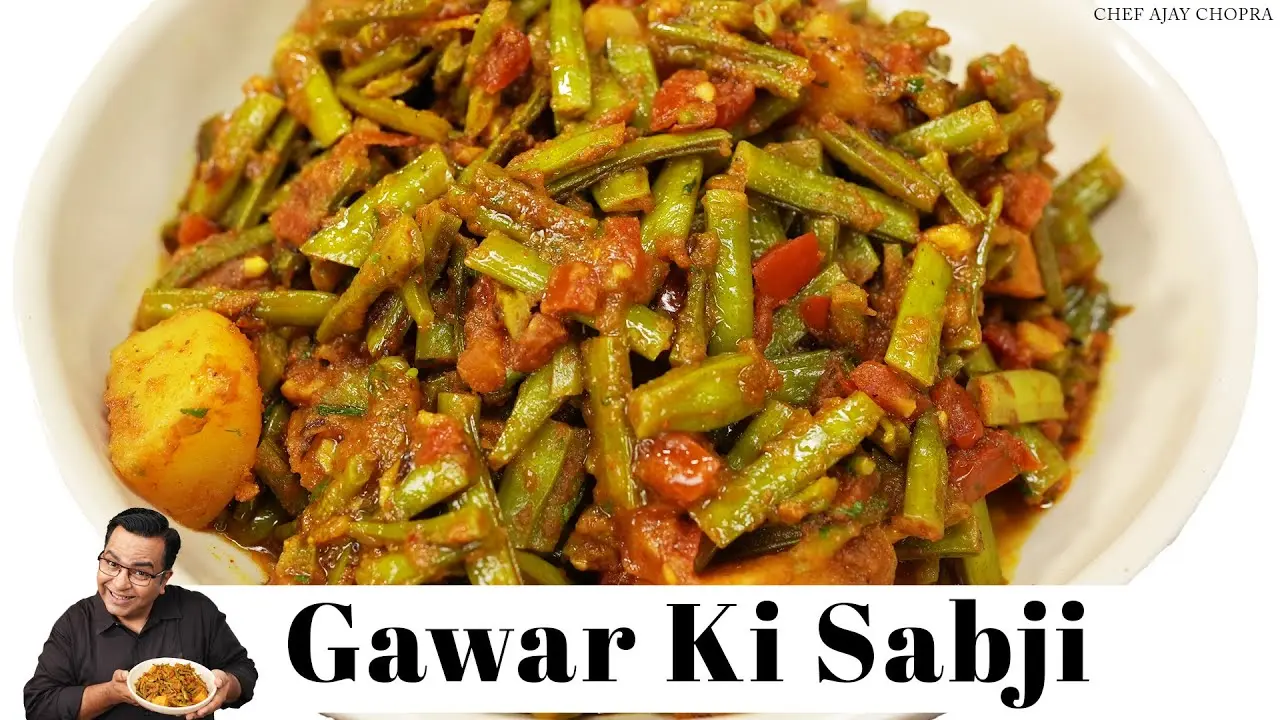
Gavar ki sabji Recipe

30 Mins

4-5 People

05 Mins
Introduction
I remember the first time I tried Gavar ki Sabji; I was quite skeptical about its taste. Gawar, or cluster beans, wasn't a regular in our family meals. My curiosity piqued one day when I visited my grandmother, and she had prepared this dish with such love and care. She explained how this humble vegetable, often overlooked, has a unique taste that stands out when cooked with the right spices.
Interestingly, my grandmother told me that the trick to making Gavar ki Sabji truly delicious is to blanch the beans first. This little step helps in removing the slight bitterness that cluster beans are known for. Ever since, it's become one of my favorite go-to recipes for a quick and healthy meal. Now, I can't wait to share this flavorful and nutritious recipe with you.
Recipe of Gavar ki Sabji
Ingredients
For the Gawar Beans:
- Gavar (Cluster Beans): 500 grams
- Water: As required
- Salt: 1 teaspoon
For the Masala Base:
- Mustard oil: 3 tablespoons
- Jeera (Cumin seeds): 1 teaspoon
- Green chilies: 2 pcs (split into spicy and non-spicy)
- Garlic (chopped): 1 tablespoon
- Green chili (chopped): ½ tablespoon
- Ginger (chopped): 1 teaspoon
- Onion: 3 medium-sized pcs (paste)
- Potato: 2 medium-sized pcs (peeled and diced)
- Salt: 1 teaspoon
- Turmeric powder: ½ teaspoon
- Coriander powder: 1 teaspoon
- Kashmiri chili powder: 1 teaspoon
- Water: Splash for cooking
- Tomato: 2 medium-sized pcs (chopped)
- Blanched gawar beans
- Sabji masala: 1 teaspoon
- Water: As required
- Coriander (chopped): 1 tablespoon
For Serving:
- Roti dough
- Ghee
Instructions
Step 1: Prepare the Gawar Beans
- Wash the Beans: Wash the gawar beans thoroughly under running water to remove any dirt or debris.
- Trim and Cut: Trim both ends of the beans and remove any strings along the sides. Cut the beans into 1-inch pieces.
- Blanch the Beans: In a large pot, bring water to a boil. Add a generous pinch of salt and blanch the beans for about 5-7 minutes. This helps to remove their natural bitterness.
- Drain and Set Aside: Drain the blanched beans and set them aside for later use.
Step 2: Prepare the Masala Base
- Heat the Oil: Heat 3 tablespoons of mustard oil in a deep pan or kadhai over medium heat. Allow the oil to heat until it starts to smoke slightly to reduce its pungency.
- Add the Spices: Add 1 teaspoon of cumin seeds to the hot oil and let them splutter.
- Sauté Aromatics: Add the chopped garlic, spicy green chilies, less spicy green chilies, and chopped ginger. Sauté until the garlic turns golden brown and the chilies are aromatic.
Step 3: Cook the Onion Paste
- Add the Onion Paste: Add the paste of 3 medium-sized onions to the pan, stirring continuously.
- Cook the Paste: Cook the paste until it turns a golden brown color. This forms the base flavor of the dish, so ensure it’s well-cooked.
Step 4: Incorporate the Potatoes
- Add the Potatoes: Add the diced potatoes to the onion mixture. Sauté the potatoes until they are about 80% cooked, stirring occasionally to prevent sticking. This should take about 10 minutes.
Step 5: Add the Spices
- Sprinkle the Spices: Sprinkle 1 teaspoon of salt, ½ teaspoon of turmeric powder, 1 teaspoon of coriander powder, and 1 teaspoon of Kashmiri chili powder over the potatoes and onion mixture.
- Add Water: Add a splash of water to prevent the spices from burning and to keep the masala moist.
Step 6: Cook the Tomatoes
- Add the Tomatoes: Add the chopped tomatoes to the pan. Stir well to combine with the masala.
- Cook the Tomatoes: Cook the tomatoes until they become soft and mushy, integrating well with the spices to form a thick sauce.
Step 7: Combine Gawar and Final Cooking
- Add the Beans: Once the tomatoes are well-cooked, add the blanched gawar beans to the pan.
- Add Sabji Masala: Sprinkle 1 teaspoon of sabji masala over the mixture and add a little more water to ensure there is enough moisture for the beans and potatoes to cook thoroughly.
- Simmer and Cook: Cover the pan with a lid and let it simmer on low heat until the potatoes and gawar are fully cooked and tender. This should take about 10-15 minutes. Stir occasionally to prevent sticking.
Step 8: For Serving
- Final Touch: Once everything is well-cooked and the flavors are melded together, turn off the heat.
- Serve Hot: Serve the hot gawar sabji with fresh, hot phulkas. You can add a little ghee on the phulkas for an extra touch of flavor.
Enjoy your delicious and nutritious Gavar ki Sabji!
About Gavar ki Sabji
Gavar ki Sabji is a traditional Indian vegetable dish made from cluster beans, which are known for their distinct flavor and high nutritional value. The recipe typically involves blanching the beans to remove their natural bitterness, followed by cooking them with a mix of spices and sometimes potatoes for added texture. The resulting dish is a perfect balance of flavors, making it a great accompaniment to Indian breads or rice. The unique preparation method not only enhances the taste but also ensures that the beans retain their nutritional benefits, including being a good source of fiber and vitamins.
Cooking Tips
- Blanch the Beans: Always blanch the gawar beans in salted water to remove their natural bitterness and to soften them slightly before cooking.
- Use Fresh Spices: Freshly ground spices can make a big difference in the flavor of the dish. If possible, grind spices like coriander and cumin just before use.
- Adjust Spice Levels: If you prefer a milder dish, reduce the number of green chilies and chili powder. You can always add a little more towards the end if you need more heat.
- Cook on Medium Heat: Cooking on medium heat ensures that the spices don't burn and the vegetables cook evenly, preserving their nutrients.
- Use Mustard Oil: Using mustard oil adds a distinctive flavor to the dish, but make sure to heat it until it reaches the smoking point to reduce its sharpness.
- Keep It Covered: When simmering the dish, keep it covered to trap the steam and help cook the beans thoroughly.
- Add Water Gradually: Add water in small amounts to control the consistency of the gravy. Too much water can dilute the flavors.
- Rest Before Serving: Let the dish sit for a few minutes after cooking to allow the flavors to meld together.
- Use Fresh Ingredients: Using fresh, quality ingredients ensures the best flavor and texture for the dish.
- Experiment with Variations: You can add other vegetables like carrots or peas for a different twist on the traditional recipe.
Pairing Guide
- Roti or Chapati: Gavar ki Sabji pairs excellently with soft, warm roti or chapati. The combination of the soft bread with the flavorful sabji makes for a satisfying meal.
- Steamed Rice: Serve the sabji with steamed rice for a wholesome and filling meal. The simplicity of the rice complements the spiciness of the sabji perfectly.
- Paratha: A flaky paratha adds a bit of richness to the meal, making it perfect for a special occasion or a comforting dinner.
- Yogurt: A side of plain yogurt or raita can help balance the heat from the spices and add a cooling element to the meal.
- Pickles: Indian pickles provide a tangy and spicy contrast that can enhance the flavors of the sabji.
- Papad: Crispy papad or poppadom adds a delightful crunch and an additional layer of texture to your meal.
- Salad: A fresh salad with cucumbers, tomatoes, and onions adds a refreshing and crunchy element to the meal.
- Dal: Pairing the sabji with a simple dal can create a well-rounded and nutritious meal.
- Chutney: Mint or coriander chutney adds a burst of fresh flavor that complements the spices in the sabji.
- Buttermilk: A glass of buttermilk helps in digestion and provides a refreshing finish to the meal.
Frequently Asked Questions about Gavar ki Sabji
-
What is Gavar ki Sabji?
- Gavar ki Sabji is a traditional Indian dish made with cluster beans cooked with spices, often combined with other vegetables like potatoes.
-
How do I remove the bitterness from cluster beans?
- To remove the bitterness from cluster beans, blanch them in salted boiling water for 1-2 minutes before cooking.
-
Can I make Gavar ki Sabji without potatoes?
- Yes, you can make Gavar ki Sabji without potatoes. Simply omit them or replace with other vegetables like carrots or peas.
-
What is the best oil to use for this recipe?
- Mustard oil is traditionally used for Gavar ki Sabji for its distinctive flavor. If unavailable, you can use any cooking oil you prefer.
-
Can I prepare Gavar ki Sabji in advance?
- Yes, you can prepare Gavar ki Sabji in advance. It keeps well in the refrigerator for 2-3 days and can be reheated before serving.
-
Is Gavar ki Sabji healthy?
- Yes, Gavar ki Sabji is healthy as cluster beans are rich in dietary fiber, vitamins, and minerals.
-
What can I serve with Gavar ki Sabji?
- Gavar ki Sabji can be served with roti, paratha, steamed rice, or as part of a larger Indian meal with dal and other sides.
-
Can I add other spices to the recipe?
- Yes, you can add other spices like garam masala or cumin powder to enhance the flavor according to your taste preference.
-
Is Gavar ki Sabji suitable for vegans?
- Yes, Gavar ki Sabji is vegan-friendly as it does not contain any animal products.
-
How long does it take to cook Gavar ki Sabji?
- It takes about 30-40 minutes to cook Gavar ki Sabji, including preparation and cooking time.
